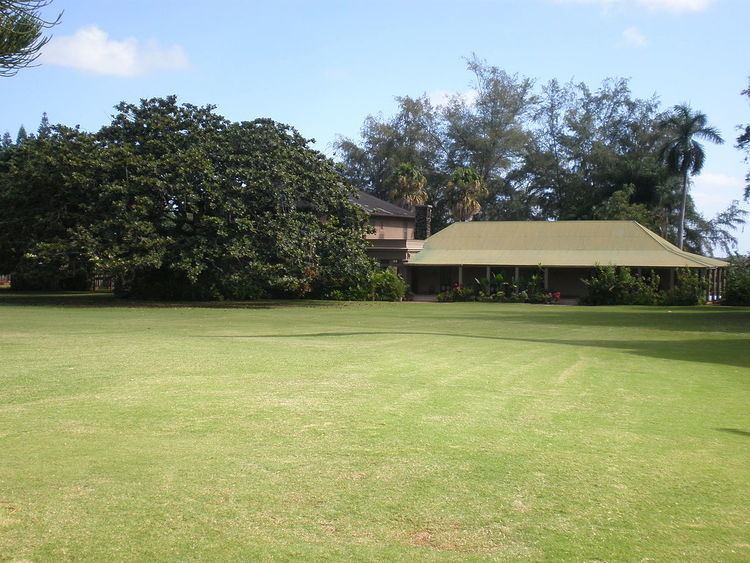Built 1854 Opened 1854 Phone +1 808-245-3202 Architect Charles William Dickey | NRHP Reference # 7400072278003436 Area 32 ha Added to NRHP 25 June 1974 | |
 | ||
Address 4050 Nawiliwili Rd, Lihue, HI 96766, USA Hours Closed today FridayClosedSaturdayClosedSundayClosedMonday10AM–1PMTuesdayClosedWednesday10AM–1PMThursday10AM–1PM Similar Ninini Point Lighthouse Cache Site, Immaculate Conception Catholic, Kalapaki Beach, Kilohana, Wailua Falls | ||
Grove Farm is a historic agricultural site on Kauai in the Hawaiian Islands.
History
German immigrant Hermann A. Widemann (1822–1899) started one of the first sugarcane plantations in Hawaii known as Grove Farm in 1854. During the American Civil War, the demand for Hawaii sugar grew, but Widemann supported the Confederate States. After leasing Grove Farm to its manager George Norton Wilcox (1839–1933) in November 1864, Widemann moved to Honolulu to work in the capital as a supreme court judge. Wilcox would later buy the plantation, and it remained in the family for over 100 years. Wilcox had an irrigation system built to bring water from the wet mountains to the flatter lower elevations where the crops were grown. This idea was later copied by many other planters in the islands.
In 1881 Princess Ruth Keʻelikolani sold some adjoining land, which grew the acreage by about a factor of ten. In 1903 the family hired Charles William Dickey to design a house for Ralph Wilcox and his wife Daisy Rice. Dickey also supervised a renovation of the main house in 1915 which removed interior walls to create large open spaces. From 1913 to 1917 a row of small houses were built for plantation workers. The houses were called Kaipu Camp after the Hawaiian name for a Chinese foreman of the plantation.
The main estate house has two bedrooms, writing room, two bathrooms, and a library on the first floor. A grand staircase leads up to the second floor which has more bedrooms. Behind the main house is a hexagonal gazebo styled after a Japanese teahouse, built in 1898. To the south is a guest cottage with two living areas from about 1890. Another single story cottage was built in 1877 for George Wilcox, and an office building was built in 1884. A number of support buildings include sheds and a garage.
Wilcox died in 1933, and the farm was left to nieces and nephews. This included the six children of his brother Samuel Wilcox (1847–1929) and Emma Lyman (1849–1943), daughter of missionary David Belden Lyman. During World War II the farm started to diversify by growing other food crops to feed the growing population of the islands, including the military. In 1948, Grove Farm purchased the 3,000-acre (1,200 ha) McBryde plantation which included the Koloa sugar mill. By 1974, sugar production was leased to Alexander & Baldwin, while the company moved into residential and resort real estate operations.
The Wilcox estate was added to the National Register of Historic Places listings in Hawaii on June 25, 1974 as site 74000722. Its boundary was adjusted to total 81.79 acres (33.10 ha) on December 8, 1978, and site changed to 78003436.
The main house is now a private museum, the Grove Farm Sugar Plantation Museum, with tours by appointment. It is located on Hawaii Route 58, known as Nawiliwili Road. The 2 ft 6 in (762 mm) narrow gauge Grove Farm Company Locomotives were stored in a warehouse just to the west in the area known as Puhi, also listed on the NRHP, and formerly owned by Mabel Wilcox. Some of the restored trains can be ridden about once a month on the Lihue Plantation Railroad located at the site of the Lihue Plantation Sugar Mill nearby.
In the 1990s all sugarcane production ended in the area. A golf course designed for the former plantation called Puakea was partially built when Hurricane Iniki hit in 1992. It opened with ten holes in 1997. It has come to be a full, 18 hole golf course. In 2000 Grove Farm was bought by Steve Case. In July 2001 he also bought the neighboring Lihue plantation, for a total of about 40,000 acres (16,000 ha). Case's grandfather A. Hebard Case had worked on the plantation. He paid US$25 million and assumed $60 million of debt, but was sued by Wilcox family shareholders since his father had served as lawyer for the Grove Farm company. The firm hired by Case to do the evaluation, Aspen Venture Group LLC, was headed by Michael James Burns Jr. who was on work release from prison, serving a sentence for theft. The lawsuit went to court but was dismissed in 2008. Case has proposed more development, characterized as green building.
